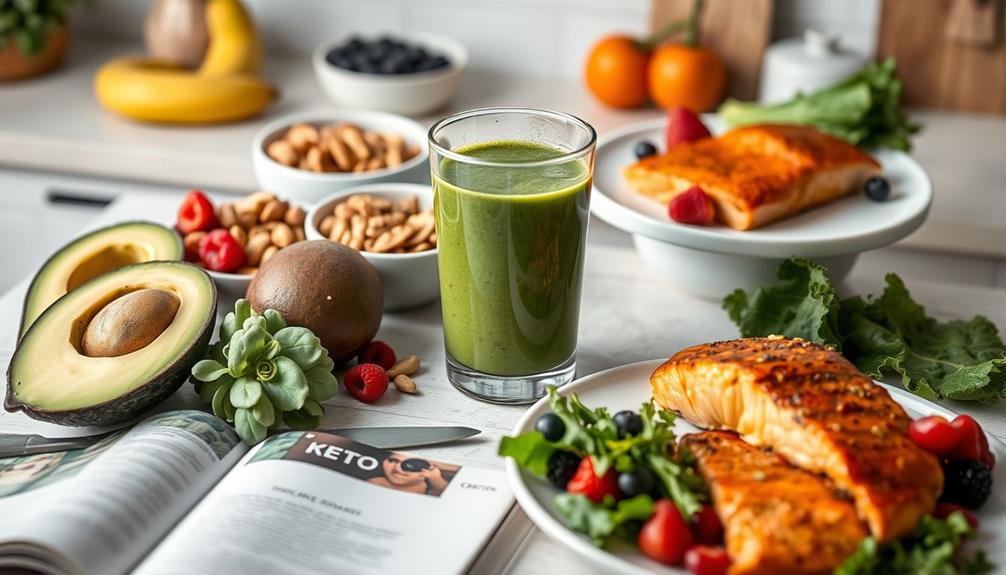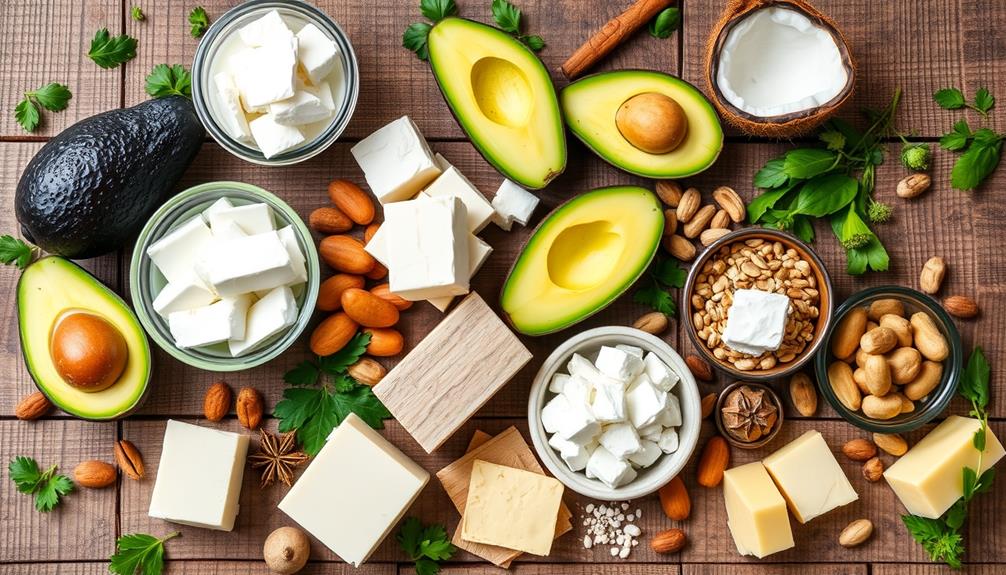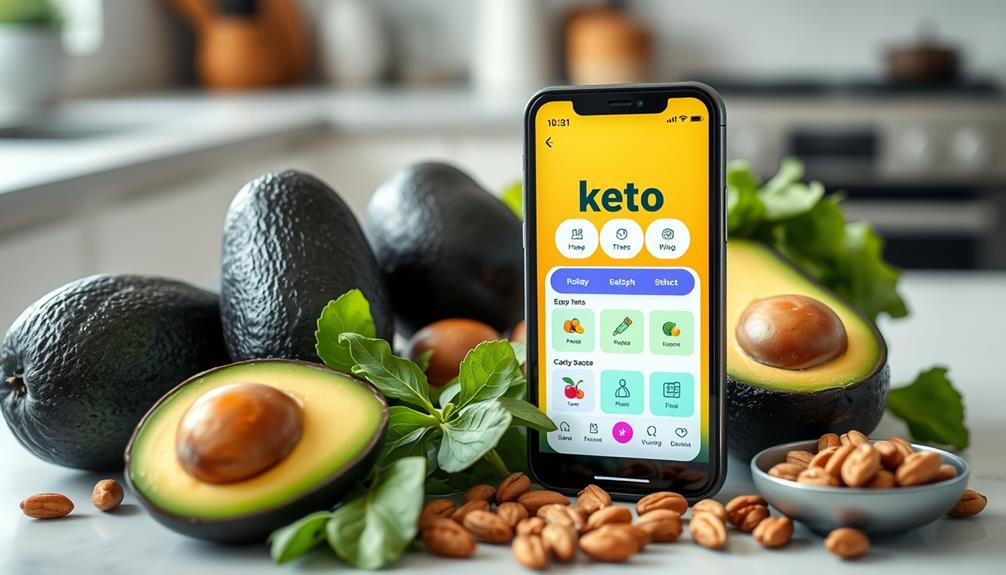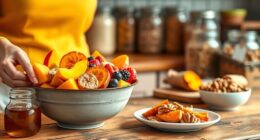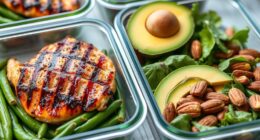To jump-start your keto diet, focus on reducing your carb intake to about 20-50 grams daily, which helps your body enter ketosis. Incorporate healthy fats like avocados, olive oil, and nuts while choosing low-carb vegetables such as leafy greens. Consider adding MCT oil for quick energy and to boost your fat consumption. Stay hydrated, as dehydration can occur when cutting carbs, and keep an eye on your electrolyte levels. Start gradually to minimize "keto flu" symptoms like fatigue. These strategies set the foundation for your success, and there's more insight into making your keto journey smoother ahead.
Key Takeaways
- Reduce carbohydrate intake to 20-50 grams per day to initiate ketosis effectively.
- Incorporate healthy fats such as avocados, nuts, and olive oil for optimal energy sources.
- Stay hydrated and focus on electrolyte balance to prevent "keto flu" symptoms.
- Gradually introduce MCT oil for quick energy and enhanced ketosis support.
- Monitor your ketone levels using urine strips or blood meters to track progress.
Understanding Ketosis
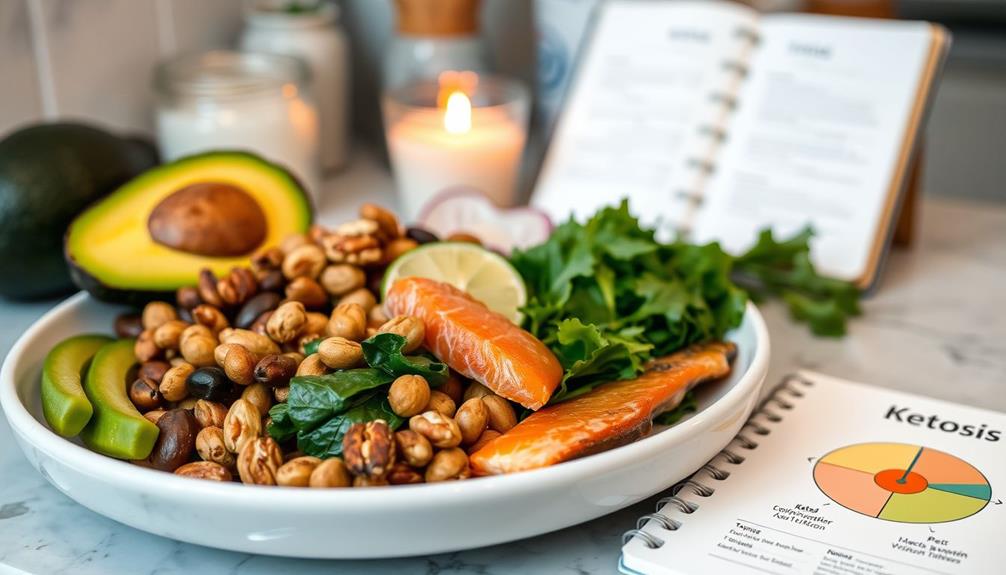
Understanding ketosis is essential for anyone looking to jump-start their keto diet. Ketosis is a metabolic state where your body shifts from using glucose to burning fat as its primary fuel source. Achieving this state typically involves drastically reducing your carb intake to about 20-50 grams per day.
When your carb intake drops, your liver converts fatty acids into ketone bodies, which become your body's alternative energy source. This process leads to increased fat burning and often reduces your hunger. Additionally, incorporating high-antioxidant foods like celery juice can support your health during this change.
The change into ketosis usually takes about 2-4 days, but individual factors like your metabolic rate and activity level can impact how quickly you adapt. During this initial phase, you might experience symptoms known as the "keto flu," including fatigue, irritability, headaches, and digestive discomfort as your body adjusts to using fat instead of carbs for energy.
To guarantee you're in ketosis, regularly testing your ketone levels through urine strips, breath analyzers, or blood tests can be very helpful. Monitoring these levels will guide you in making necessary dietary adjustments, ensuring you stay on track with your ketogenic diet and maximize fat burning.
Essential Keto Foods

When starting on a keto diet, stocking your kitchen with essential keto foods is critical for success. These foods will help you maintain low carb intake and promote ketosis, making it easier to reach your health goals.
Focus on incorporating options that provide healthy fats and dietary fat, which are essential for staying in ketosis. Additionally, understanding the importance of hydration and proper nutrition can greatly enhance your keto experience, as seen in dietary guidelines for other health conditions like gout management.
Here's a list of essential keto foods you should have on hand:
- Avocados: Packed with healthy fats and fiber.
- Nuts and seeds: Great for snacking and rich in nutrients.
- Oils: Use olive oil and coconut oil for cooking; they're high in medium-chain triglycerides.
- Non-starchy vegetables: Leafy greens and broccoli are low carb and nutrient-dense.
- Fatty cuts of meat: Choose options like ribeye or salmon to boost your dietary fat intake.
Additionally, consider stocking up on keto-friendly snacks, such as pork rinds and cheese, to support intermittent fasting and keep hunger at bay.
Strategies to Reduce Carbs
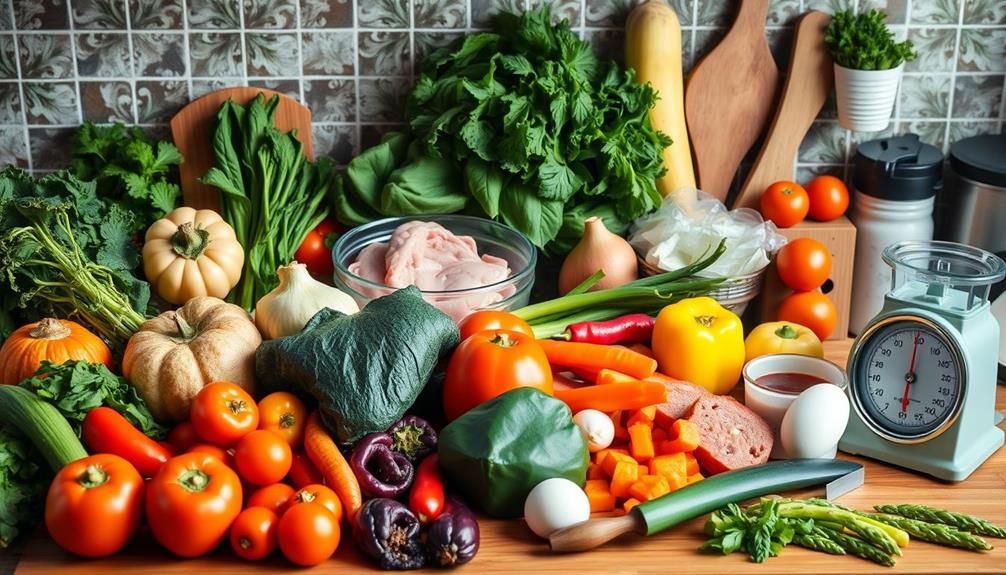
To effectively reduce carbs, you need to identify hidden sources that can sneak into your meals.
Incorporating a balanced diet rich in whole foods is vital during this process, as it can help you stay on track without feeling deprived.
Meal prepping is essential, as it helps you control ingredients and portion sizes, ensuring you stick to your carb limits.
Identify Hidden Carbs
Maneuvering the world of hidden carbs can be tricky, but with a little diligence, you can streamline your ketogenic journey. Start by paying close attention to nutrition labels; they're your best friend in this process.
Here are some strategies to identify hidden carbs:
- Check for added sugars in sauces and condiments.
- Avoid low-fat or fat-free products that often contain unexpected carbs.
- Limit fruits, legumes, and starchy vegetables like potatoes and corn.
- Read ingredient lists for sneaky fillers like maltodextrin and dextrose.
- Use a food tracking app to monitor your daily carb intake.
Meal Prep Essentials
Starting your keto journey with effective meal prep can greatly reduce your carb intake and set you up for success. Begin by crafting a meal plan that focuses on non-starchy vegetables, healthy fats, and moderate protein. Keeping your carb intake below 20-30 grams per day is essential for maintaining ketosis.
Additionally, incorporating mindfulness practices can help you stay aware of your eating habits and reduce emotional eating, enhancing your commitment to the diet. For more insights on healthy eating habits, check out effective strategies for weight loss.
Next, create a grocery list filled with keto-friendly foods such as avocados, olive oil, fatty fish, and nuts. Avoid high-carb items like bread, pasta, and sugary snacks.
Batch-cook meals like casseroles or stir-fries in advance. This minimizes the temptation of high-carb options when you're hungry.
Incorporate portion control by using containers to pre-portion your snacks and meals. This makes it easier to stick to low-carb choices while you're on the go.
Meal prep tools like a slow cooker or instant pot can also simplify your cooking process, allowing you to whip up delicious, low-carb meals with minimal effort.
Increasing Healthy Fats

To successfully boost your keto diet, focus on incorporating high-quality fat sources like avocados, nuts, and olive oil into your meals.
Additionally, consider using essential oils such as eucalyptus oil for its health benefits that can complement your wellness journey.
Experiment with adding these fats to snacks and dishes while keeping an eye on portion sizes to maintain a balanced intake.
Sources of Healthy Fats
Healthy fats are essential for successfully maintaining a ketogenic diet, making up 70-80% of your total daily caloric intake. Incorporating the right sources of healthy fats can help you achieve and maintain ketosis effectively.
Additionally, understanding your budget for food expenditures can help you make healthier choices while staying within your financial means, as creating a personal budget is crucial for financial health.
Here are some excellent options to take into account:
- MCT oil: Quickly absorbed and converted into ketones, it boosts your energy levels.
- Olive oil: Extra virgin olive oil is rich in monounsaturated fats and antioxidants that support heart health.
- Fatty fish: Salmon and mackerel are packed with omega-3 fatty acids, promoting reduced inflammation and better cardiovascular health.
- Nuts: Almonds, walnuts, and macadamia nuts offer a perfect combo of healthy fats, fiber, and essential nutrients.
- Seeds: Chia seeds and flaxseeds are great sources of healthy fats and can enhance your daily nutrient intake.
Incorporating Fats Into Meals
Incorporating fats into your meals can considerably enhance your ketogenic journey and keep you satisfied throughout the day. By focusing on healthy fats, you can promote ketosis and support weight loss effectively. Here are some great options to include in your high-fat diet:
| Type of Fat | How to Use | Benefits |
|---|---|---|
| Olive Oil | Dressings and cooking | Rich in antioxidants, heart-healthy |
| Avocado Oil | Drizzle on salads and veggies | High in monounsaturated fats |
| Coconut Oil | Cooking and baking | Supports metabolism and energy |
| Fatty Fish (Salmon) | Main course or salads | Rich in omega-3 fatty acids |
Don't forget about avocados! They're not just delicious but also high in healthy fats and fiber, keeping you full longer. Nuts and seeds like almonds and chia seeds are perfect snacks that offer protein without spiking carbs. You can even experiment with grass-fed butter or ghee in your coffee or vegetables for added flavor and concentrated healthy fats. By incorporating these fats, you'll fuel your body while enjoying a satisfying variety of meals.
Balancing Fat Intake
Balancing your fat intake is essential for maximizing the benefits of a ketogenic diet. To effectively enter ketosis and maintain it, aim for healthy fats to make up 70-80% of your daily caloric intake. You'll want to replace carbohydrate calories with fat calories, limiting your carbs to 20-50 grams per day.
Incorporating a variety of healthy fats not only supports your diet but can also enhance your overall coffee experience, as certain fats can complement coffee flavors beautifully, making your beverage even more enjoyable in the morning unique aroma in homes.
Here are some healthy fats to incorporate into your low-carb eating plan:
- Avocados: Packed with fiber and nutrients.
- Olive oil: Ideal for cooking and drizzling on salads.
- Nuts: Great for snacking, but watch portion sizes.
- Fatty fish: Salmon and mackerel provide omega-3s.
- Coconut oil: A fantastic source of medium-chain triglycerides (MCTs).
Utilize cooking methods that enhance fat consumption, like sautéing veggies in olive oil or adding coconut oil to smoothies.
Remember, while incorporating healthy fats, avoid unhealthy options like trans fats found in processed foods, which can undermine your progress.
Incorporating MCT Oil
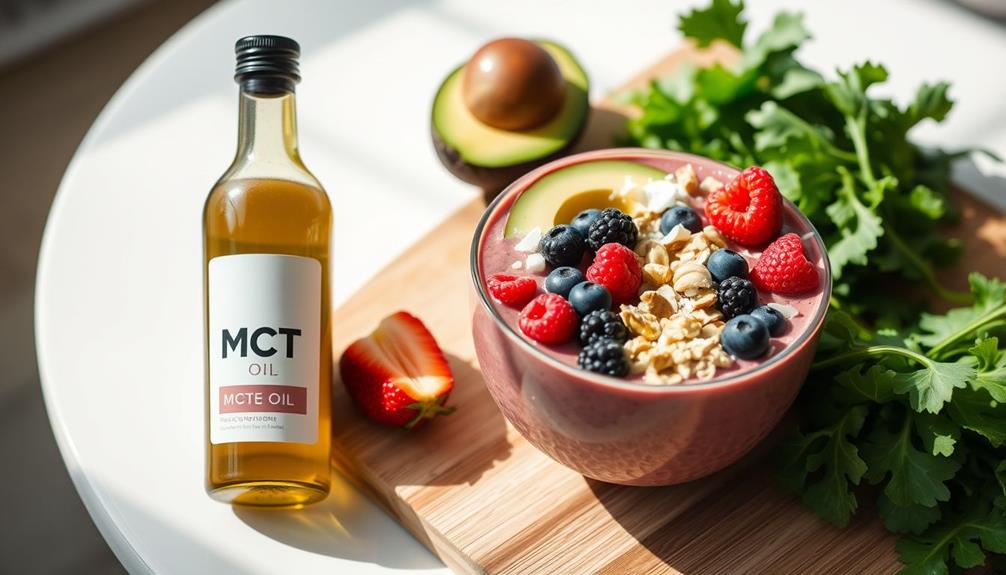
MCT oil is a powerful ally in your keto journey, providing a quick source of energy that can help you stay on track. Derived from coconut oil, MCT oil contains medium-chain triglycerides that rapidly convert into ketones, giving you an immediate energy boost. This is essential for enhancing cognitive function and improving physical performance while following a ketogenic diet.
To start, mix 1 teaspoon of MCT oil into your daily routine, gradually increasing to 1-2 tablespoons to avoid digestive discomfort. You can easily incorporate it into smoothies, coffee, or salad dressings without changing the flavor of your meals.
Here's how MCT oil can support your keto goals:
| Benefit | Description | Emotional Impact |
|---|---|---|
| Energy Boost | Quickly fuels your body with energy | Feel invigorated |
| Supports Weight Loss | Promotes feelings of fullness | Experience satisfaction |
| Enhances Cognitive Function | Improves mental clarity | Boost confidence |
| Aids Fat Oxidation | Helps utilize fat for fuel | Achieve your goals |
Benefits of Intermittent Fasting

When you're kickstarting your keto journey, pairing your diet with intermittent fasting can supercharge your results.
This powerful combination accelerates your path to ketosis and enhances fat burning.
Additionally, understanding the potential benefits of cryptocurrency investments can provide a broader perspective on financial health, just as intermittent fasting enhances your metabolic health.
Here's how intermittent fasting can benefit you:
- Depletes glycogen stores, prompting your body to burn fat for energy.
- Increases ketone production, helping you enter ketosis faster.
- Regulates insulin sensitivity, improving blood sugar control and support for weight loss.
- Reduces appetite and cravings, making it easier to stick to your low-carb plan.
- Promotes autophagy, aiding cellular repair and boosting overall metabolic health.
Monitoring Ketone Levels
To effectively track your progress on the keto diet, monitoring your ketone levels is vital. You can use three primary methods: urine test strips, blood ketone meters, and breath acetone meters.
While urine test strips can indicate the presence of acetoacetate, their accuracy decreases as your body adapts to ketosis. Incorporating advanced technology into your monitoring can enhance precision, similar to how high-performance units are rated for extreme temperatures in heat pumps.
Blood ketone meters provide the most precise results, making them a reliable choice if you want to verify you're in the ideal range.
Breath acetone meters, like the Ketonix, offer a non-invasive alternative, measuring acetone levels in your breath without the need for blood or urine tests.
Regularly testing your ketone levels helps you adjust your carb intake, keeping it below the recommended threshold of 20-50 grams per day to maintain ketosis.
Additionally, monitoring ketone levels allows you to manage glucose spikes effectively. By keeping tabs on your body's ketone production, you can make better dietary choices and stay on track with your keto goals.
This proactive approach will ultimately support your journey towards achieving and maintaining ketosis.
Staying Hydrated and Balanced

Staying hydrated is crucial for your success on a keto diet, especially since your body loses more water and electrolytes when you cut carbs.
Regularly checking your hydration levels can help you avoid common pitfalls like fatigue or headaches, similar to how you should maintain air quality in your home.
You should aim for at least 2-3 liters of water daily and consider adding electrolyte-rich foods or supplements to keep your levels balanced.
Importance of Electrolyte Balance
Electrolyte balance plays an essential role in your success on a ketogenic diet. As your body adapts to ketosis, it excretes higher levels of sodium, potassium, and magnesium, which can lead to symptoms of the "keto flu" if not managed properly.
To stay hydrated and balanced, you'll want to focus on your electrolyte intake. Just as providing your pets with healthy dog snacks is important for their well-being, ensuring you maintain your electrolyte levels is crucial for your health during this dietary change.
Consider these key elements to maintain optimal electrolyte balance:
- Sodium: Aim for 3,000-5,000 mg daily.
- Potassium: Target around 4,700 mg to help with muscle function.
- Magnesium: Aim for 300 mg to support overall well-being.
- Hydration: Drink about 2-3 liters of water each day.
- Electrolyte-rich foods: Incorporate avocados, leafy greens, and bone broth into your meals.
Pay attention to how your body responds during the initial stages of your ketogenic diet. Some individuals may require more support than others, so adjusting your hydration and electrolyte intake is essential.
Hydration Strategies for Ketosis
Hydration is essential when you're on a ketogenic diet, as your body tends to lose more water and electrolytes due to lower insulin levels. This increased urination can lead to dehydration, especially during the initial phase of ketosis. To combat this, aim to drink at least 2-3 liters of water daily.
Incorporating electrolytes like sodium, potassium, and magnesium into your diet is important for maintaining mineral balance. These minerals often deplete during ketosis, which can exacerbate symptoms of the "keto flu," such as fatigue and headaches. Consider using electrolyte supplements or simply adding a pinch of salt to your meals.
Monitoring your hydration levels is also essential. Check the color of your urine regularly; pale yellow indicates good hydration, while dark yellow suggests you need to increase your water intake.
Managing Keto Flu Symptoms

Jumping into a keto diet can sometimes come with a rough start, commonly known as the "keto flu." This phase often brings symptoms like fatigue, headaches, and irritability as your body adjusts to burning fat for fuel instead of carbohydrates.
To manage these symptoms effectively, here are some strategies you can implement:
- Stay hydrated: Drink plenty of water to combat dehydration.
- Boost electrolytes: Consider adding broth or supplements rich in sodium, potassium, and magnesium.
- Reduce carbs gradually: Instead of cutting carbohydrate intake all at once, ease into it to lessen the impact of the shift.
- Incorporate healthy fats: Focus on consuming quality fats like avocados, olive oil, and nuts to provide sustained energy.
- Moderate protein intake: Confirm you're getting enough protein to support your body during this adjustment.
Long-Term Sustainability Tips
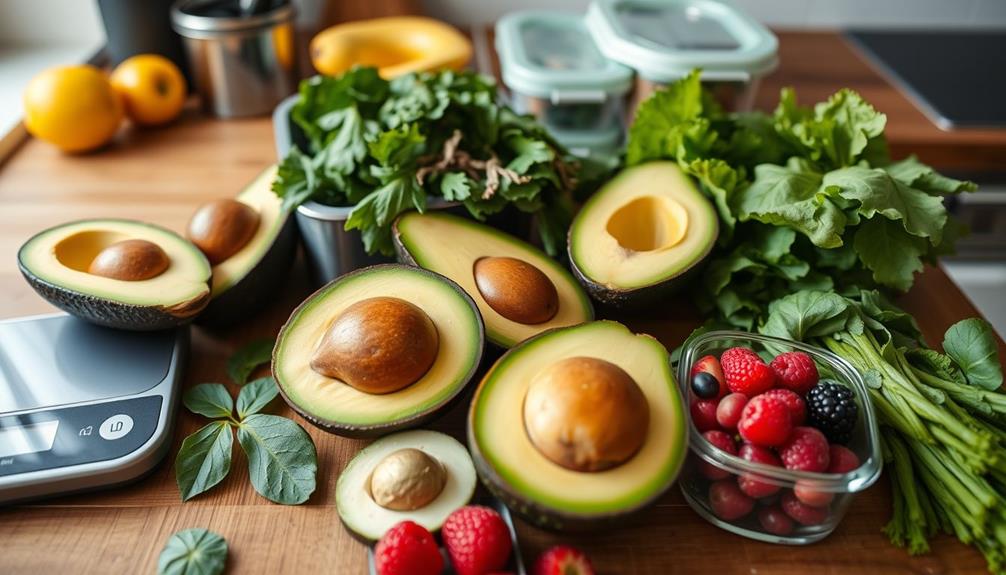
Once you've navigated the initial challenges of the keto flu, the next step is to confirm your keto journey is sustainable in the long run. Start by incorporating a variety of non-starchy vegetables, healthy fats, and moderate protein sources into your meals. This balance prevents nutrient deficiencies and keeps your diet enjoyable.
Regularly monitor your ketone levels using urine strips or blood tests. This guarantees you stay within the desired range and can adjust your dietary intake as needed for ideal results.
Once you reach your weight loss goals, gradually reintroduce healthy carbohydrates. Doing so helps create a balanced eating pattern that fosters lasting lifestyle changes and prevents yo-yo dieting.
Don't forget the importance of physical activity. Engage in both aerobic and resistance training to enhance fat loss, support muscle maintenance, and improve your overall metabolic health while on the keto diet.
Lastly, seek social support through online forums or local keto groups. Sharing experiences, recipes, and tips with others can keep you motivated and accountable as you navigate this journey.
Making these adjustments will help confirm your keto lifestyle remains fulfilling and sustainable.
Frequently Asked Questions
How to Jump Start the Keto Diet?
To jump start your keto diet, cut carbs to 20-50 grams daily, increase healthy fats, exercise regularly, consider intermittent fasting, and monitor ketone levels to track your progress and optimize your approach. By cutting carbs and increasing healthy fats, your body will enter a state of ketosis, where it burns fat for fuel instead of carbohydrates. This can lead to increased weight loss, improved energy levels, and better mental clarity. By exercising regularly and considering intermittent fasting, you can further enhance the benefits of the keto diet, such as improved insulin sensitivity and reduced inflammation. Monitoring your ketone levels will help you stay on track and ensure you are reaping the full keto diet benefits.
How to Kick Start Ketosis Again?
To kick start ketosis again, drastically cut carbs to 20-50 grams daily. Incorporate intermittent fasting, increase healthy fats, stay active, and monitor your ketone levels to guarantee you're effectively shifting back into fat-burning mode.
How Do I Restart My Keto Fast?
"You can't make an omelet without breaking a few eggs." To restart your keto fast, cut carbs, embrace healthy fats, incorporate intermittent fasting, stay hydrated, and monitor your ketone levels. You'll shift back smoothly.
What Puts You in Ketosis Fastest?
To enter ketosis quickly, limit your carbs to 20-50 grams daily, incorporate MCTs, engage in high-intensity workouts, and consider intermittent fasting. Regularly check your ketone levels to stay on track.
Conclusion
Jump-starting your keto diet is like igniting a fire; with the right fuel and attention, it can blaze brightly. By understanding ketosis, stocking up on essential foods, and keeping an eye on your carb intake, you'll set yourself up for success. Remember to stay hydrated and manage any keto flu symptoms that arise. With these strategies in place, you'll not only reach your goals but also enjoy a sustainable lifestyle that keeps you feeling great.
